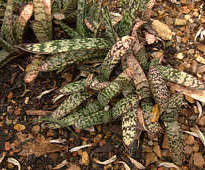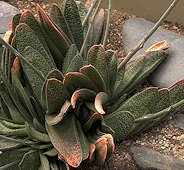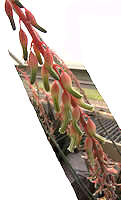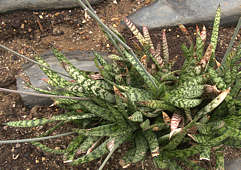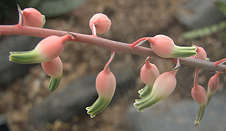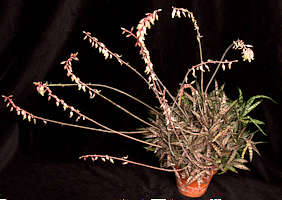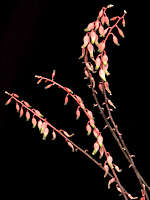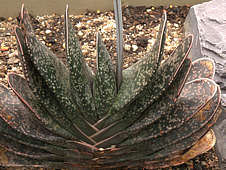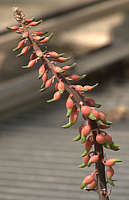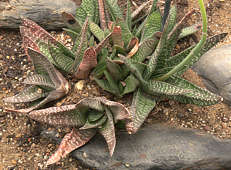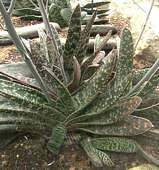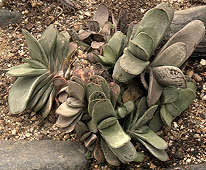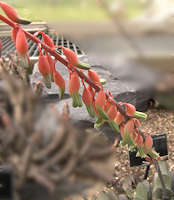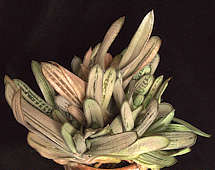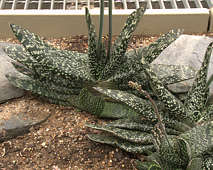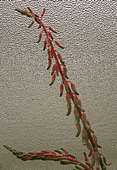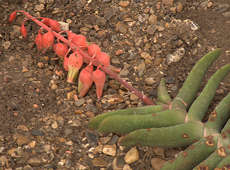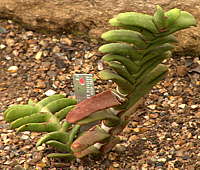The majority of Old World succulent monocotyledons are grouped into the Aloaceae, a medium sized family of rosulate leaf succulents including Aloe, Astroloba, Bulbine, Chortolirion, Gasteria, Haworthia and Poellnitzia. The largest genus is Aloe with more than 400 species. The Aloaceae are distributed across southern Africa, Arabia, Madagascar and the Mascarene Islands. A few Bulbines are found in Australia.
This page focuses on the small genus of undemanding succulent plants, Gasteria.
|
Gasteria Duval (1809)
Name: Greek gaster = stomach, referring to the flower shape.
The 16 species of Gasteria are native to Southern Africa. Their succulent leaves range from an inch to over a foot in length. Leaves are produced in a linear array (distichous), but plants may become rosulate with age. The usually flattish leaves have a waxy surface, which may be attractively banded, furnished with white spots or warty. Leaves of the most fleshy species can be quite brittle. A few species have large triangular leaves. Leaf margins are smooth and may be acute or rounded, usually with an acute tip.
Gasterias are popular undemanding indoor succulent plants, tolerating a little shade and infrequent watering. However, some sun ensures a compact growth habit, attractive leaf colouration in some species and abundant flowers. It is a mistake to allow these attractive plants to languish under the staging. The racemes of decorative pink to red flowers produce a good show in the Spring and intermittently throughout the summer. The individual tubular flowers have a distinctive basal bulbosity. The exact shape varies between species and divides the plants into taxonomic groups. Gasteria flowers are edible, raw or cooked and a traditional component of stews.
Gasterias seem resistant to most pests, but may be treated prophylactically with systemic insecticides. Leaves are prone to unsightly black spots, which may be discouraged by avoiding humidity and condensation. The black spots will not spread and are the result of the plant sealing off damage or fungal infection with phenolic substances, which oxidise to a dark colour.
Single leaves or even a broken part, placed with the basal end touching damp compost will root and produce a whole plant. This takes time but can be useful to resurrect a damaged plant.
|
|
Click on the pictures below for a higher quality image.
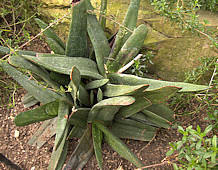 |
 |
Gasteria acinacifolia (J. Jacquin) Haworth 1819
The largest species in the genus, with light green triangular succulent leaves spotted in white. Young plants have a distichous arrangement of blunt-ended leaves. Mature plants have sharply pointed leaves forming a rosette. The flower spike is a 3ft multi-branched raceme of tubular pink flowers bearing longitudinal light and dark strips and with exserted yellow stamens.
Native to the Eastern Cape of South Africa.
|
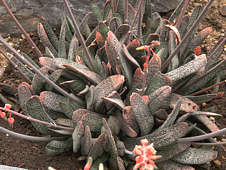 |
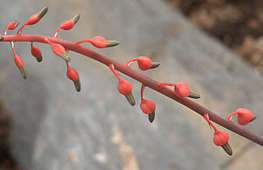 |
Gasteria baylissiana Rauh 1977
A medium-sized species whose dark green succulent leaves are covered in nearly confluent, white tubercles giving an overall greyish appearance.
Native to the Eastern Cape of South Africa.
|
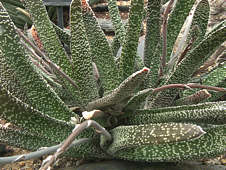 |
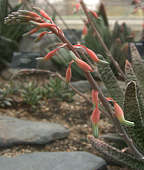 |
Gasteria carinata var. verrucosa van Jaarsveld 1992
Another variable subspecies whose leaf surfaces are covered with many tiny white tubercles.
|
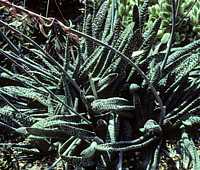 |
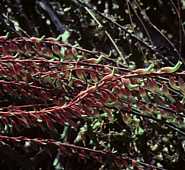 |
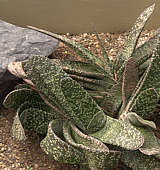 |
|
Above: G. carinata var. verrucosa van Jaarsveld 1992
Syn. G. verrucosa Duval 1809 |
Above: G. carinata var. verrucosa
Syn. G. verrucosa var. latifolia Haworth 1821 |
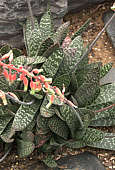 |
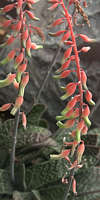 |
Gasteria disticha Haworth 1827 (Beestong = ox tongue)
This species from the Western Cape includes numerous synonyms that were once separate species.
|
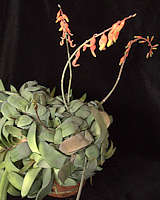 |
 |
Gasteria glomerata van Jaarsveld 1991
A compact succulent plant with an unspotted but slightly roughened grey-green leaf surface. Leaves grow in a single line (distichous) but the plant clumps up freely to make a mat.
Native to the Eastern Cape of South Africa.
|
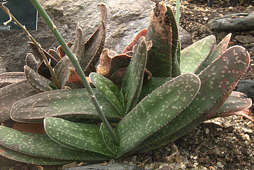 |
 |
Gasteria multipunctata
This doesn't seem to be a valid name. May be of garden origin.
|
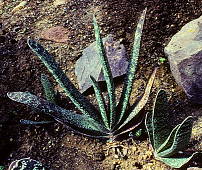 |
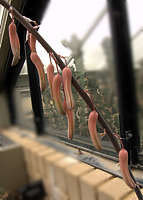 |
Gasteria pillansii Kensit 1909
Native to Namibia and the Northern Cape of South Africa.
|
|
Gasteria rawlinsonii Obermeyer 1976 (Cliff Gasteria, Kransbeestong)
Named for: Mr. I. Rawlinson, South African collector of succulent plants.
This succulent plant generally grows in a pendulous manner, but tends to sprawl if grown on a flat surface. The roots are fleshy. The narrow, linear succulent leaves are arranged in two rows (distichous) or may spiral. The leaves are green with faint white spots on their surface but may become reddened in strong light. Leaf margins may have a few small prickles.
Gasteria rawlinsonii is native to the Baviaanskloof mountains of the Eastern Cape of South Africa, where it grows hanging down sandstone cliffs.
|
|
 |
Literature |
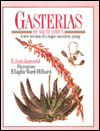
|
Gasterias of South Africa: A New Revision of a Major Succulent Group
by E.J. van Jaarsveld (1994)
Publisher: Fernwood Press (Pty) Ltd., Vlaeberg, South Africa. ISBN: 1-874950-01-6
A beautifully illustrated classic that may be available secondhand.
|
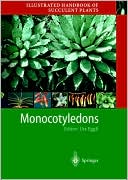
|
Illustrated Handbook of Succulent Plants: Monocotyledons
Edited by Urs Eggli (2001)
Publisher: Springer-Verlag New York. ISBN: 3540416927
Volume relevant to Gasteria from a series of comprehensive taxonomic treatments of succulent plants.
|
|

 Families of Succulent Plants
Families of Succulent Plants 






